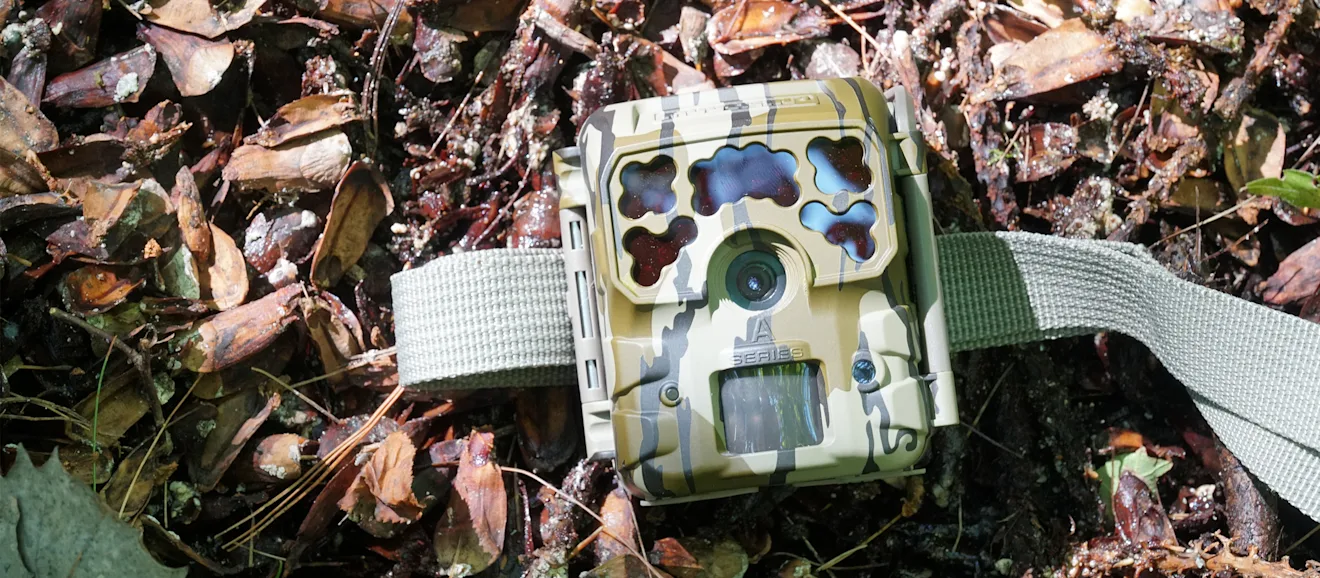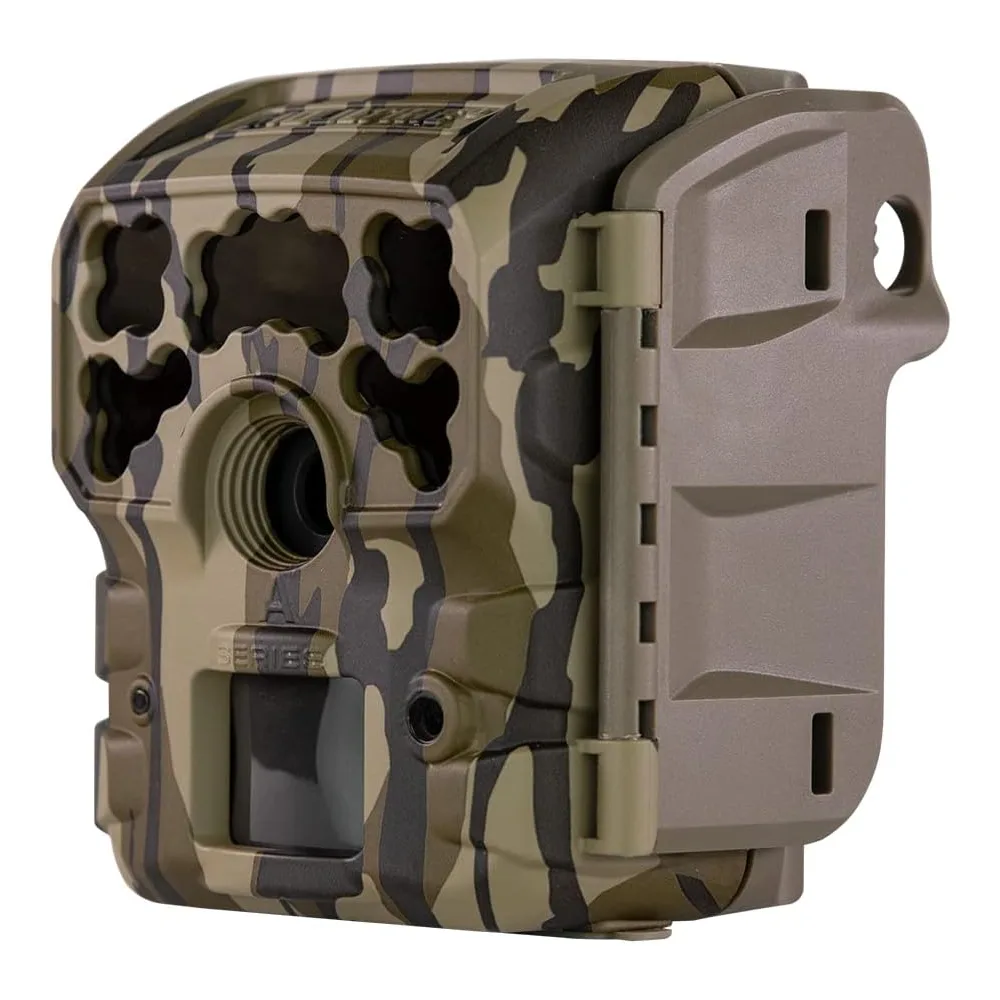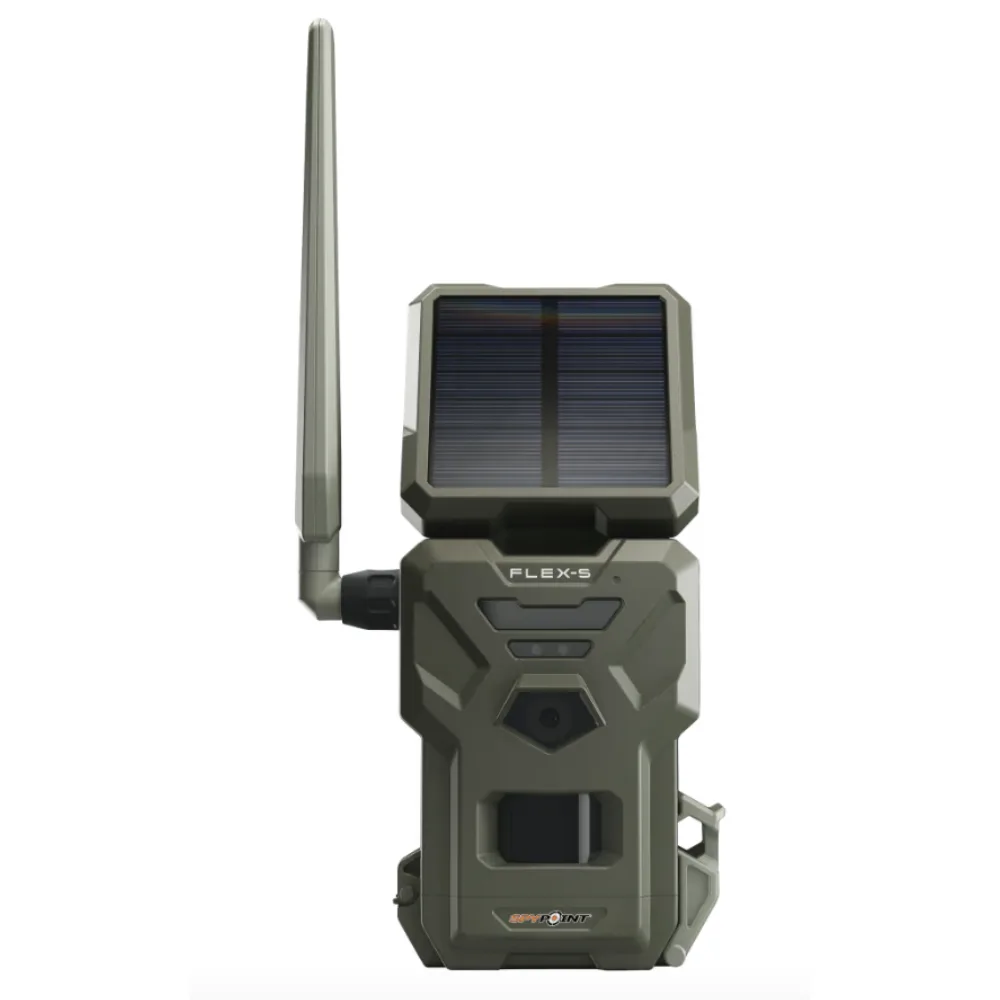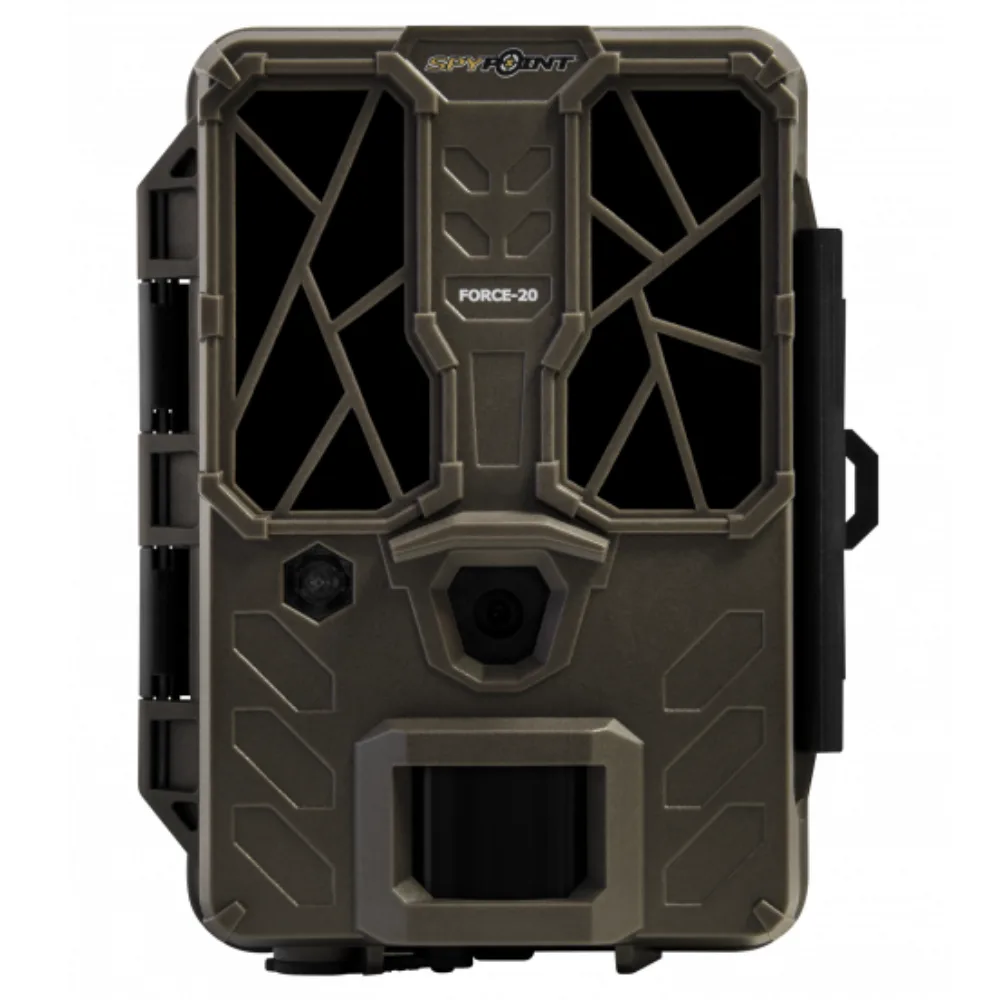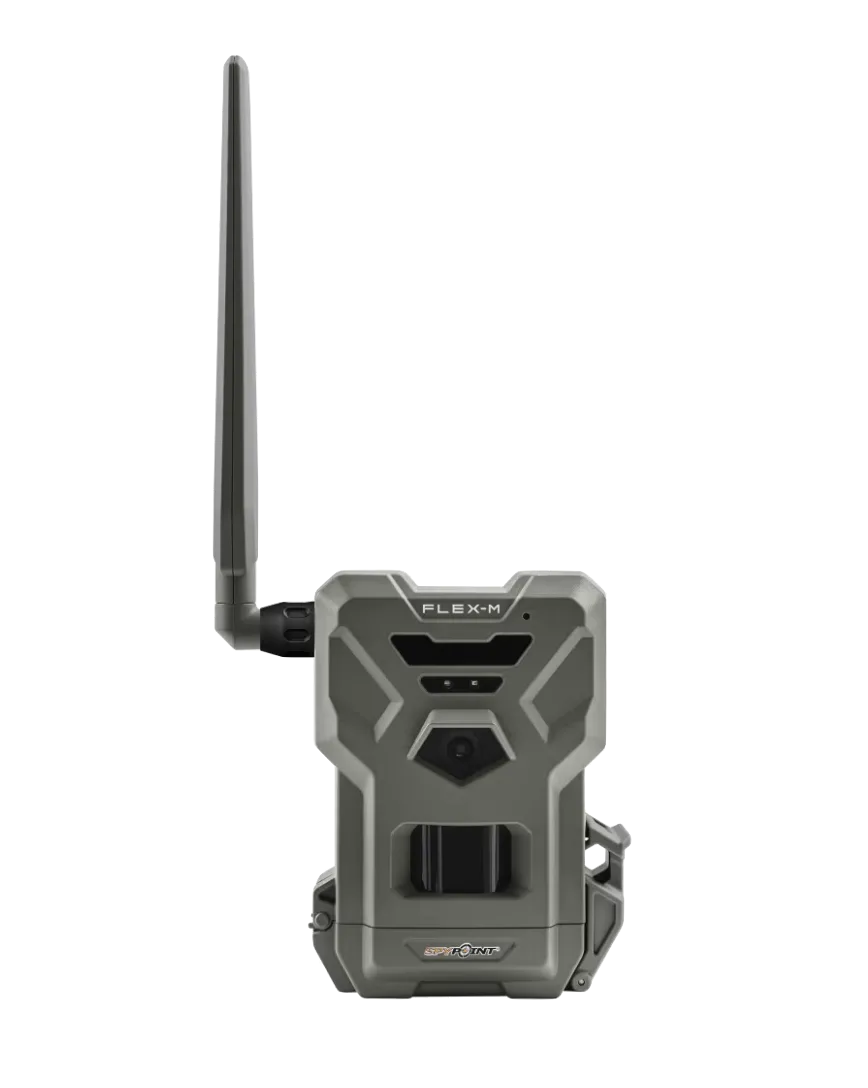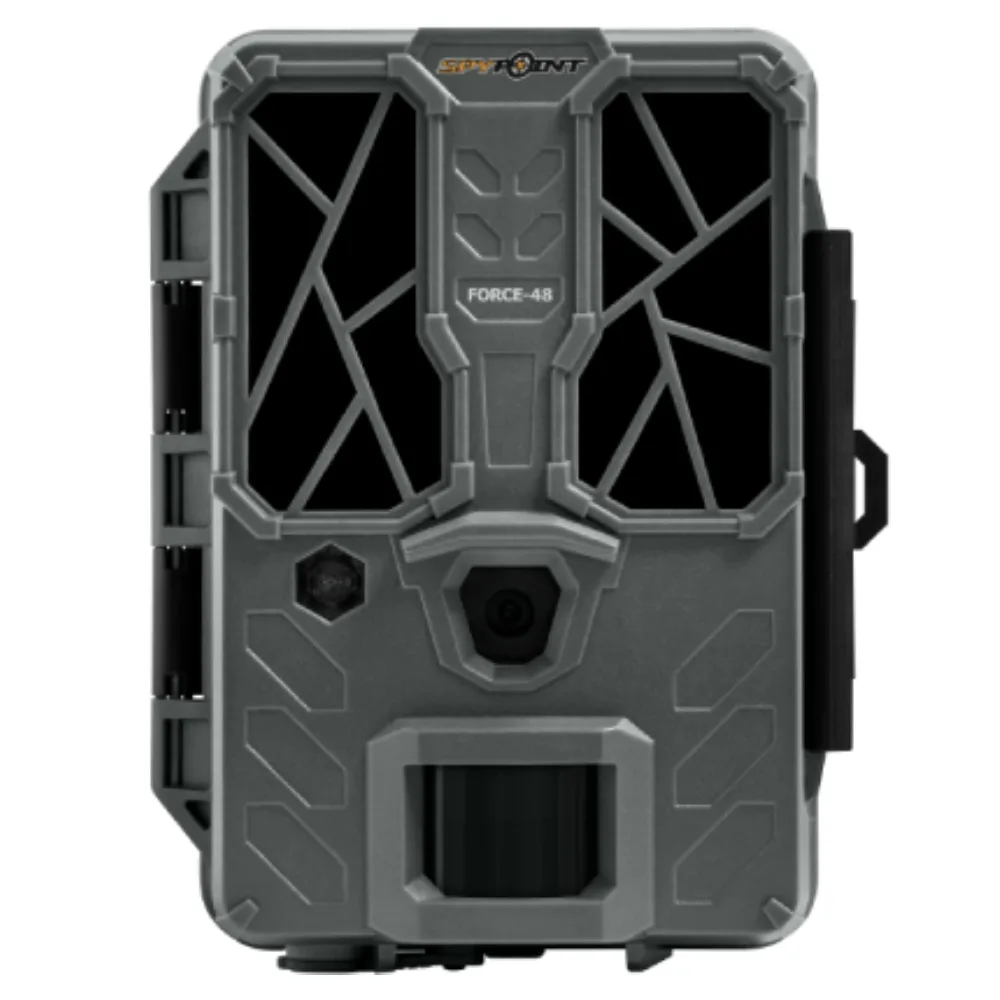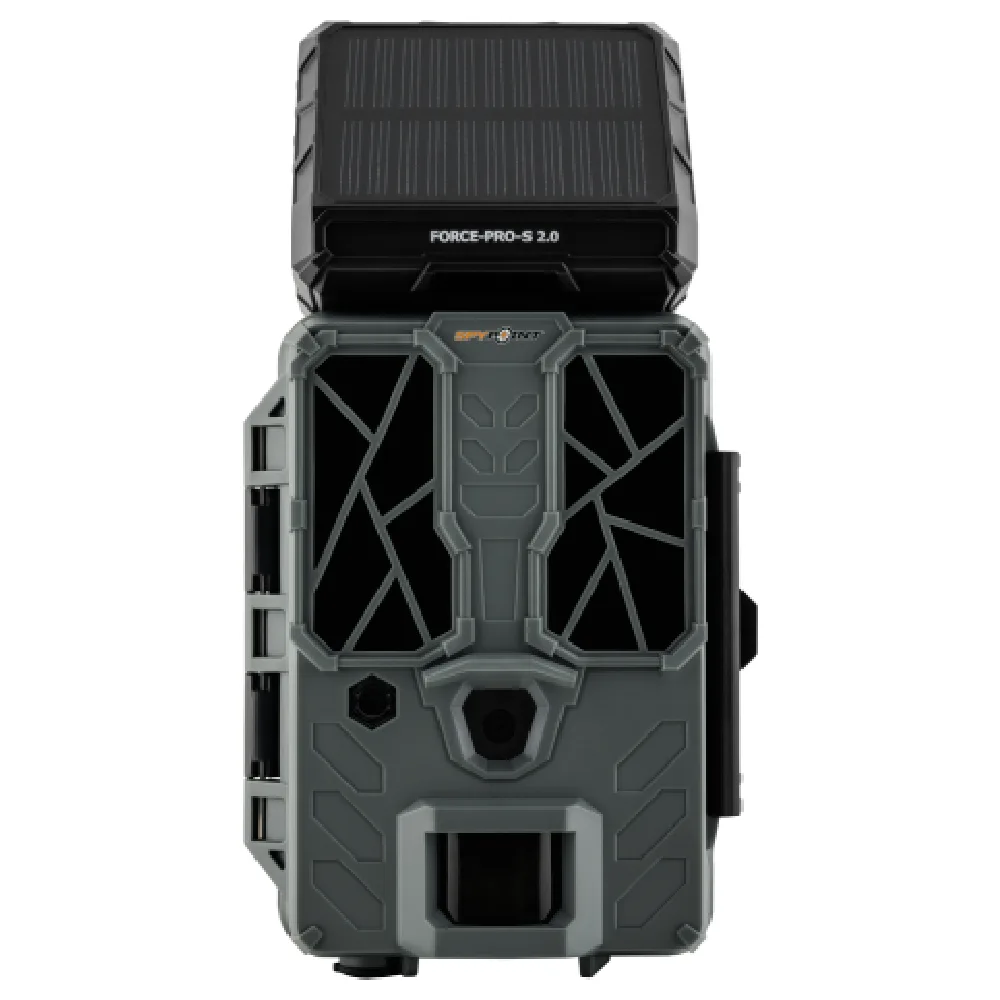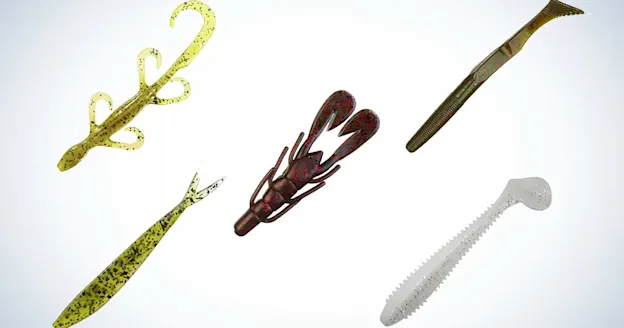We may earn revenue from the products available on this page and participate in affiliate programs. Learn more ›
Not so long ago, "budget trail camera" pretty much meant "bad trail camera." But that's all changed now, and it's great news for hunters. For most of us, scouting with trail cams boils to a numbers game. The more cameras you have out there working for you, the better chance you have of capturing a picture of that trophy buck. And there's never been a better time to expand your arsenal.
Like a lot tech gadgets—and unlike everything else, it seems—trail cameras keep getting cheaper and better, to the point where we now have high-quality cell cams for as little as $80 and workhorse conventional cameras for around $70. Bottom line, it’s a good time to buy, and to help you narrow down the choices, we spent weeks testing the latest budget cellular and conventional trail cameras on the market. Here are our favorites.
Best Overall: Moultrie Micro-42i Kit
Best Cellular: Spypoint Flex-M
Best Tech for the Money: Tactacam Reveal X Gen 3.0
Best Picture Quality for the Money: Spypoint Force-48
Rest of the Best
Best Overall: Moultrie Micro-42i Kit
Specs
Trigger Speed: 0.4 seconds
Detection Range: 70 feet
Flash Range: 80 feet
Flash Type: No-glow
Camera: 42 MP
Pros
Very affordable
Compact size
Solid trigger speed
Decent detection ranges
Cons
No-glow flash might affect night picture quality at longer ranges.
Just to be clear, "best budget" isn't the same as "best value." If you found a new Lamborghini Revuelto for a quarter million, you be getting a killer deal—but no one would call it a budget vehicle. To us, "best budget" means the most affordable model that will still get the job done reliably—and by that definition, it's tough to beat the Moultrie Mico-42i Kit.
You can find it for around $70 if you poke around (or click the link above), and what you get is a very capable and wonderfully small and handy camera. One of the coolest things about the 42i is its compatibility with Moultrie’s Moultrie Mobile system (provided you add a modem), which links cameras together to send pics to your phone or tablet; in essence, you’re getting another wireless cam without paying the price. But, of course, if you don't want to deal with that, you can just run it as the hardworking no-glow conventional cam it is. The 42i'strigger speed is very good for a budget camera, and with its compact size (3-1/4” X 3-1/2” X 2-½”), this unit can be strapped to smaller trees and still be nearly invisible to wildlife. With no-glow flash and its small size, it would be a good choice for a security camera too. Moultrie also offers a two-year warranty.
Best Cellular: Spypoint Flex-M
Specs
Trigger speed: 0.4 seconds
Detection range: 90 feet
Power: 8 AA batteries
Flash Range: >90 feet
Flash Type: 4 LED IR
Camera: 28 megapixel
Pros
Incredibly affordable
Great overall performance for the money
Time Lapse+ hybrid motion and time-lapse captures
Cons
Flimsy antenna
Requires micro-SD card (sold separately)

When it comes to budget trail cameras, we felt we couldn't give the "Best Overall" award to a cellular unit simply because of the service fees you'll wrack up over time. But if it's the best budget cellular cam your looking for, specifically, then the new-for-2024 Spypoint Flex-M is your huckleberry. At just $80, it is far and away the hottest deal in cellular trail cameras today and actually costs less than most non-cellular cameras. It also isn’t a battery hog and lets you run the camera on just 8 AA batteries. There are two-packs of this camera on sale right now for $130, giving you a solid cellular option for around $65 per camera.
If you're wondering if that crazy-low price means the camera junk, you can put that thought to rest. In our testing, the Flex-M's trigger speed, detection range, and picture quality all punched way above its price, and earned the camera the Best Value award in our recent test of all the best cellular cameras. The images I got with the Flex-M were every bit as good, if not better, than some from much more expensive cameras in that test. It captured both day and night images beyond its advertised 90-foot detection range on our walk-by test. Setup through the Spypoint app was easy and straightforward, too. And while the antenna is a bit flimsy, it can be removed for transport. In the backcountry or on the back-40, the Flex-M gives you the most camera for the money by a long shot when it comes to cellular units.
Best Tech for the Money: Tactacam Reveal X 3.0
Specs
Trigger Speed: Under 0.5 seconds
Detection Range: 96 feet
Flash Range: 96 feet
Flash Type: Low-Glow IR
Power: 12 AA Batteries, rechargeable pack, solar, or external battery
Pros
Live aiming via the app
Solid construction and design
Long range nighttime shots
Cons
No on-board screen

The Reveal X 3.0 is the cheaper little brother of Tactacam's new Reveal Pro 3.0 (which won our Best Overall award in the latest cell cam test). As such, it’s missing a few of the higher-end features, like an on-board screen, no-glow flash, and video on demand. But it makes up for this with a longer nighttime detection range, a similar flexible antenna design, and the same improved image sensors as the Reveal Pro. It shot some of the best photos, day or night, during our cell-cam test and got a lot of points for camera body design.
The Reveal X doesn’t require an SD card, but it still has a slot for one should you want to use it. This makes it a versatile camera capable of working in areas without cell service. Paired up with the Tactacam app, it’s fully GPS capable and lets you access mapping and live-camera aiming—all for around a $125. If it weren't for the Spypoint Flex-M above, this would have won our best budget cell-cam award, but the higher price tag is understandable here and may well be worth it to you. The Reveal X is a feature-rich, performance-driven camera that’s still a great deal.
Best Picture Quality for the Money: Spypoint Force-48
Specs
Trigger speed: 0.5 seconds
Detection range: 80 feet
Flash Range: 80 feet
Flash Type: 48 low-glow LEDs
Camera: 48 Megapixel
Power: 8 AA batteries
Pros
Dirt cheap
Solid picture quality for the money
Easy setup
Cons
SD card not included
Below-average trigger speed
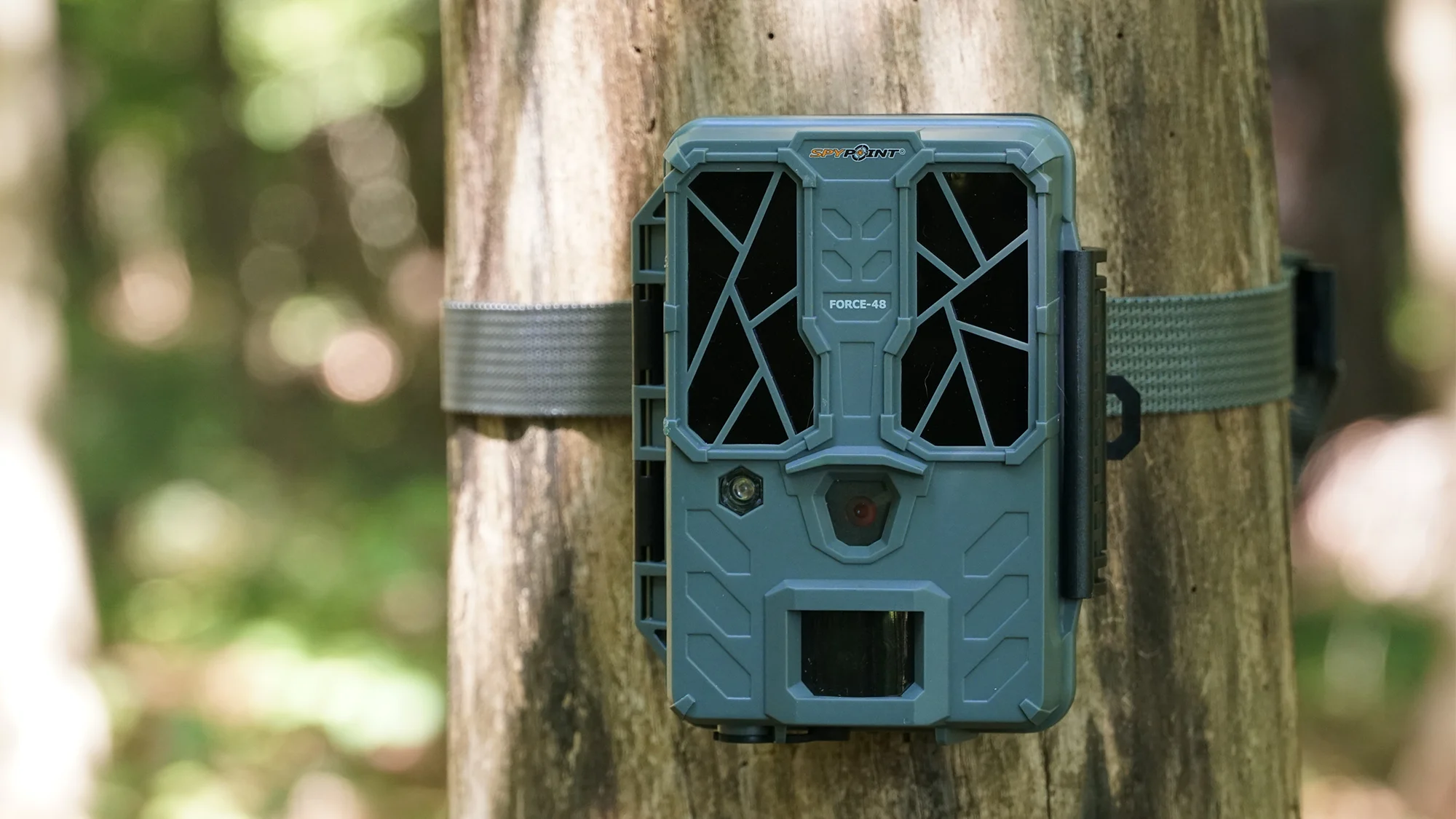
If you're someone who values picture quality above all else, and you're looking to spend under $100, the Force-48 should be just right for you. We're not saying it takes the best pictures of any camera on this list (for that, look to the Tactacam above or the Browning below). What we're saying is that you won't find another $70 camera that takes better ones.
Make no mistake, the Force-48 is a very basic trail camera. If you’re looking beef up your trail-cam arsenal for a large property or to cover large tracts of public land, the Force-48 will let you do it without breaking the bank. With the ability to capture 720p video with sound and a 48-megapixel camera, it will do everything you need a camera to do, even though it won’t knock your socks off in terms of performance.
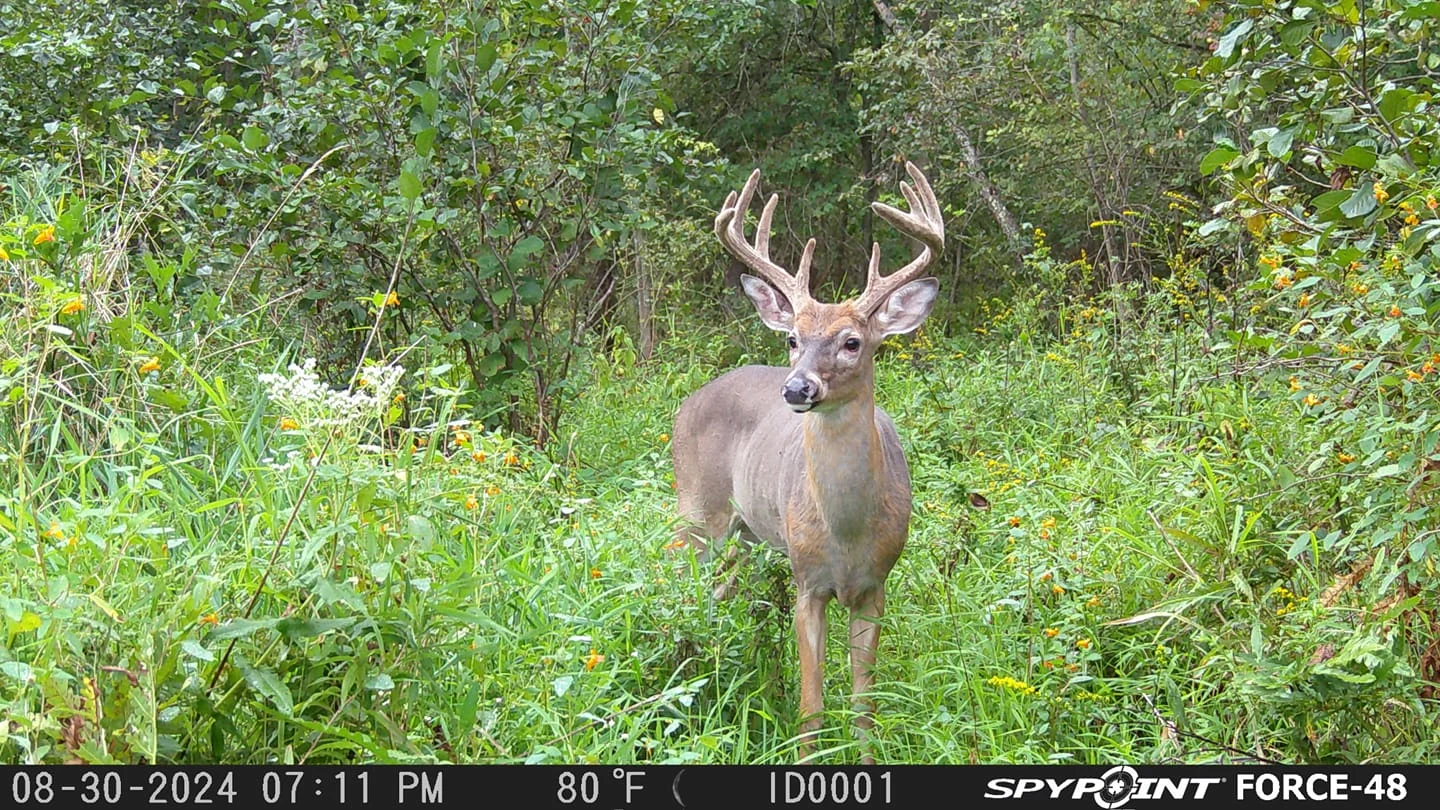
The need to buy a separate SD card is the biggest issue withe Force-48. We experienced some formatting issues during the test, and found that Spypoint cards work best. You’ll have plenty of money left over to buy one, though. And while the trigger speed is a bit slow, the Force-48 still kept up with most of the other cameras here. Pick up one or six of these cameras this season, and you won’t be disappointed.
Spypoint Force-Pro-S 2.0
Specs
Trigger speed: 0.2 second
Detection range: 110 feet
Power: 8 AA batteries, plus on-board solar
Pros
Solar panel included
Time Lapse+ feature
Cons
Screen impossible to use for angling camera
This camera costs $150. So, why it is on our list of best budget cams? Simple. Because it comes with a the built-in solar panel that over time is going to save you more than the difference in price to other cams on this list.

It also happens to be a great trail camera, with a super-fast trigger, the longest detection range on any camera we tested this year, and first-rate picture quality, to boot. The Pro-S 2.0 also has a huge screen, which makes set-up a breeze, and it can be programmed for Spypoint’s Time Lapse+, giving you the ability to capture images for set time intervals while still taking motion-activated images. So, if you're willing to pay a little more up front, you'll save in the end, and you'll have a high-end performing camera working for you the whole time.
Stealth Cam Fusion Pro Max
Specs
Trigger Speed: 0.4 seconds
Detection Range: 80 feet
Flash Type: IR
Camera: 36 MP (adjustable)
Pros
Decent trigger speed
Adjustable resolution
Option for solar power
Cons
IR flash will result in blurrier night pics
The Fusion X strikes a nice balance between performance and affordability. For just under $100, you get a cell cam with a trigger that as fast or faster than most similarly priced conventional cams. During our testing, the Fusion delivered good, clear images. We liked the option to adjust the resolution, and the camera has a good-sized color viewing screen in the back for in-field picture review. The infrared technology ensures reliable nighttime shots; however, the infrared flash may disturb wildlife.
We really appreciate that the unit comes with batteries included, so it’s ready to go right out of the box, and saves you a little money right away. But more notably, it offers the purchase option of adding the Stealth’s SOLPAK, a solar power source. It’s a $69.99 investment that can save you a significant amount on batteries in the long term. In the end, the Fusion X is an affordable yet dependable scouting tool.
Browning Strike Force Pro X 1080
Specs
Trigger speed: 0.2 seconds
Detection range: 90 feet
Power: 6 AA batteries
Pros
Super fast trigger
Good pic and video quality
Excellent mounting bracket
Cons
Sticky battery tray
Smaller viewing screen
This is another camera that is not exactly cheap, at around $140, but if you look around online, you'll find that this price often includes an 32-gig SD card and a card reader, which comes in super handy when you're checking cams in the field. So, if you're someone who wants a really good conventional cam at a bit of a discount (given the savings on incidentals), the Pro X 1080 might be just right. One thing is for sure, you won't be skimping on performance.

The Strike Force Pro X 1080 simply does everything well. It sports Browning’s typically-zippy trigger and a great detection range, which, in combination, means the camera doesn’t miss much of anything. Picture quality is very good and video quality is solid, too. If the battery life on this model is anything like the many Browning cameras we've tested—and there’s no reason to think it will by any different—then you will save money there, too.
Read Next: Best Cellular Trail Cameras of 2024
How We Tested Trail Cameras
What do you shop for when looking for a budget trail camera? The same qualities you would look for in a more expensive model, but with realistic expectations. Sure, you may not get the tack-sharp pics or lightning-fast trigger speeds of a Cadillac camera, but you can still buy a perfectly serviceable camera at a price that will still let you take your family out for dinner once in a while (or, of course, have leftover money for other hunting gear).
We’ve been testing a lot of the cameras above through the years while hunting and in more formal test settings. For the newly released cameras this year, we conducted a walk-by test marked out at different distances out to 100 feet. We did this test at day and night, running, walking, and jogging by cameras to get an idea of trigger speed, advertised performance, and picture quality. We also set cameras up on deer feeders and mock scrapes to see how they performed on live deer. Finally, we evaluated cameras on ease of setup and construction, all while factoring price into the equation.
What To Look for in a Trail Camera
The most important consideration when buying a camera is your budget. We all want high quality and top performance, but often that means spending more money than we have. We’ve tried to pick cams that represent a range of prices in the “budget” category, so choose the one your wallet can handle. Second, don’t be afraid to check out word-of-mouth experiences from folks who’ve tried the model you’re considering, especially when it comes to customer service. Experienced cam-users can save you a lot of head-scratching when it comes down to choosing the best model for you. Here are some other factors to consider.
Trigger Speed
The trigger speed of a trail camera is the elapsed time between a camera’s sensor detecting game and when it actually snaps a picture. Generally, the faster the speed, the better, especially when your camera setup is likely to capture a moving animal. Speeds under 0.25 seconds are fantastic, while speeds above 0.5 aren’t so great.
Detection Range
The camera’s detection range is the furthest distance at which a camera can detect an animal and trigger a picture in daylight conditions. As a rule of thumb, the greater the distance, the better, as the camera will simply detect more game. A lot of cameras today work out to around 100 feet. Under 80 feet is below average.
Flash Range
Like detection distance, the flash range of a camera is the maximum distance at which the flash can illuminate the subject for a clean shot. This range can be affected by the type of flash the camera employs. No-glow cameras usually shoot at closer ranges, but they don’t flash while IR flash cameras have longer night-time ranges. A flash range of around 80-100 feet is ideal.
Flash Type
Standard white flash is the only kind that shoots color at night and typically results in the sharpest pictures. But white flash is also the brightest and may spook game. Red-glow flash is less detectable by wildlife, but the pics are black and white. No-glow is nearly invisible to wildlife (and people, if you also use the camera for security purposes), but flash range and picture quality often take a hit. Deciding which is best depends on your intended use of the camera.
Megapixel (MP) Rating
It’s common for manufacturers to tout their high-megapixel cameras and for buyers to be wowed, as in “an 18MP camera is over four times better than a 4MP model.” Companies can tweak their camera’s resolution by an interpolation process, where the camera’s original megapixels are enhanced or multiplied by the camera’s software. Without getting uber-technical, this process impacts the clarity of the photos.

Since manufacturers tout the megapixel rating, we’ll do it too. But fair warning; do some snooping to see examples of photos taken with the camera to get a true idea of image quality.
FAQs
Q: Can you use a trail cam as a security cam?
You can absolutely use a trail cam to guard your home, business, or property. Any good camera will capture pics of a trespasser or thief as easily as it does wild game. However, it’s wise to use a no-glow, or infrared model, as any flash projection would likely be detected by a trespasser, who will do his best to steal or disable your camera. It’s also a good idea to mount the camera discreetly to lessen the chances of its detection; I like to mount them above a person’s line of sight, pointed down at a likely point of entry, such as a door or gate. If that’s not possible, do your best to camouflage the camera instead of mounting it in a highly visible spot where the bad guys can see it.
Q: Will a trail camera pick up a mouse?
Cameras take pics whenever the sensor detects heat or motion, so yes, any moving object will trigger the camera. In fact, one of my favorite tests of a camera’s trigger speed is to mount it by one of my bird feeders. Since birds are in constant motion, the camera’s ability to take quality pics of these tiny, ever-moving “targets” says a lot about its quality. And while most of us set cameras out in hopes of getting photos of a big buck, I enjoy looking at all the non-game critters out there too. Some of my favorite pics from last season included two different bobcats, a fisher, a grey fox, and an owl.
Q: What cameras have the best battery life?
With a few exceptions, most modern cameras have pretty decent battery life. But you can do a whole lot to keep your cameras running for months. First, use lithium batteries instead of the traditional alkaline. Yes, lithiums are more expensive, but they’re worth the few extra bucks you’ll spend upfront and result in extended performance. Rechargeable batteries are another option but require a more substantial initial investment; if you’re on a tight budget, lithiums are the way to go.
Second, keep the battery chamber free of dust and dirt and use an emery cloth to keep battery contact points clean and free of oxidization. I like to stick a dryer sheet in the battery compartment to ensure ants don’t crawl in and short out the system (yes, this has happened to me more than once). If your camera is in a remote location that you can’t often access, keep it in “picture” instead of “video” mode. Videos are cool and uber fun to watch, but they are super hard on battery life. I can get months of performance from a cam in picture mode; that same unit set on video will be lucky to last a couple of weeks.
Why Trust Us
For more than 125 years, Field & Stream has been providing readers with honest and authentic coverage of outdoor gear. Our writers and editors eat, sleep, and breathe the outdoors, and that passion comes through in our product reviews. You can count on F&S to keep you up to date on the best new gear. And when we write about a product—whether it’s a bass lure or a backpack—we cover the good and the bad, so you know exactly what to expect before you decide to make a purchase.

